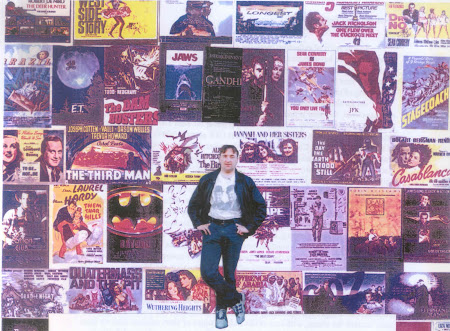In essence, it seems to be the pursuit of the seemingly insurmountable, the Big Obstacle. In Star Wars it was the Death Star; Jurassic Park resurrected the dinosaurs; Harry Potter had to overcome Valdemort and The Lord of the Rings had to reach the mountains of Mordor; E.T. had to find his way back to another planet; Titanic had its iceberg. And Jaws had its killer shark.
Back at school in the 1970's stretching through into the early 80's, the big dare amongst boastful schoolboys was "who's scared of Jaws?" Well I jolly well was, prior to first viewing, discreetly hiding at the back of the bedroom in front of a small black-and-white TV set, to minimise the shocks when they came. I well remember Robert Shaw's grisly demise, and it still puzzles me today how the film got by with a PG certificate.
The anticipation of the shark was scary, but on second or third viewing the fun of the shock was much more enjoyable. This was where the film became such a box office bonanza; audiences came back for more, and recommended those who hadn't already. Who was scared enough not to see it?
 The promising newcomer Steven Spielberg was a tender 28 when he took on Peter Benchley's bestseller, and it's the film from which his subsequent lucrative career has blossomed. But as well as being the making of him, it was very nearly the end of him too (as indeed, Star Wars was nearly the end of George Lucas.) Like many filmmakers he and the p
The promising newcomer Steven Spielberg was a tender 28 when he took on Peter Benchley's bestseller, and it's the film from which his subsequent lucrative career has blossomed. But as well as being the making of him, it was very nearly the end of him too (as indeed, Star Wars was nearly the end of George Lucas.) Like many filmmakers he and the p roducers suffered the trials on filming on water, with a specially constructed mechanical shark that soon failed to function as soon as the elaborate circuits were ruined by the effect of seawater.
roducers suffered the trials on filming on water, with a specially constructed mechanical shark that soon failed to function as soon as the elaborate circuits were ruined by the effect of seawater.What Spielberg lacked in on-screen hardware, he more than made up for with suspense, allied with an iconic score by John Williams. The famous two-note motif, much imitated, was the epitome of the film but many other lyrical elements of the score underline the atmosphere and the beauty of the setting (filmed in and around Martha's Vineyard.)
In many ways it's Spielberg's best film because the concealment of the monster's actions (as Hitchcock well knew) makes the horror seem all the greater in the audience's imagination. He also garnered helpful performances out of his three leading actors; at first glance all they had to do was react to the deadly fish swimming around them, but Robert Shaw was never the sort of actor who came second to anything, least of all a shark, and the atmosphere improves immeasurably as soon as he looms onto the screen as the Ahab-like Quint. Richard Dreyfuss also provides a good deal of cherubic postgraduate contrast as younger shark fanatic Hooper, and either side of these two the film is anchored unobtrusively by Roy Scheider as Chief Brody, who holds it all together.
 Their interaction is especially effective in the chatty but memorable after-dinner scene on board the "Orca", where the shark veterans brag over each other's experiences, brought to a head by Quint's chilling true story (guest written by John Milius) about the sinking of the USS Minneapolis, and how the sharks ate most of the remaining survivors for lunch.
Their interaction is especially effective in the chatty but memorable after-dinner scene on board the "Orca", where the shark veterans brag over each other's experiences, brought to a head by Quint's chilling true story (guest written by John Milius) about the sinking of the USS Minneapolis, and how the sharks ate most of the remaining survivors for lunch.Other watchable supporting players such as Lorraine Gary as Mrs Brody (who flirts mildly with Hooper at the dinner table), the redoubtable Murray Hamilton as the shifty but well-meaning May
 or of Amity Island, and even Peter Benchley himself as a TV news reporter, all have their moments (and most moving of all is Lee Fierro as a grieving parent), but once things leave dry land it's essentially about these three shark hunters and the thrill and terror of the hunt between Man and beast.
or of Amity Island, and even Peter Benchley himself as a TV news reporter, all have their moments (and most moving of all is Lee Fierro as a grieving parent), but once things leave dry land it's essentially about these three shark hunters and the thrill and terror of the hunt between Man and beast.The biggest genius of marketing was the poster
Like generations of cinemagoers avoided showers after the terror of Psycho in 1960, so audiences of the 1970's thought twice before swimming in the sea after Jaws. Many blockbusters have been made, before and since, and relied heavily on packaging as much as the film itself, but Spielberg's monsterpiece is a class apart because it is so well made, as the inferior sequels testify.








































